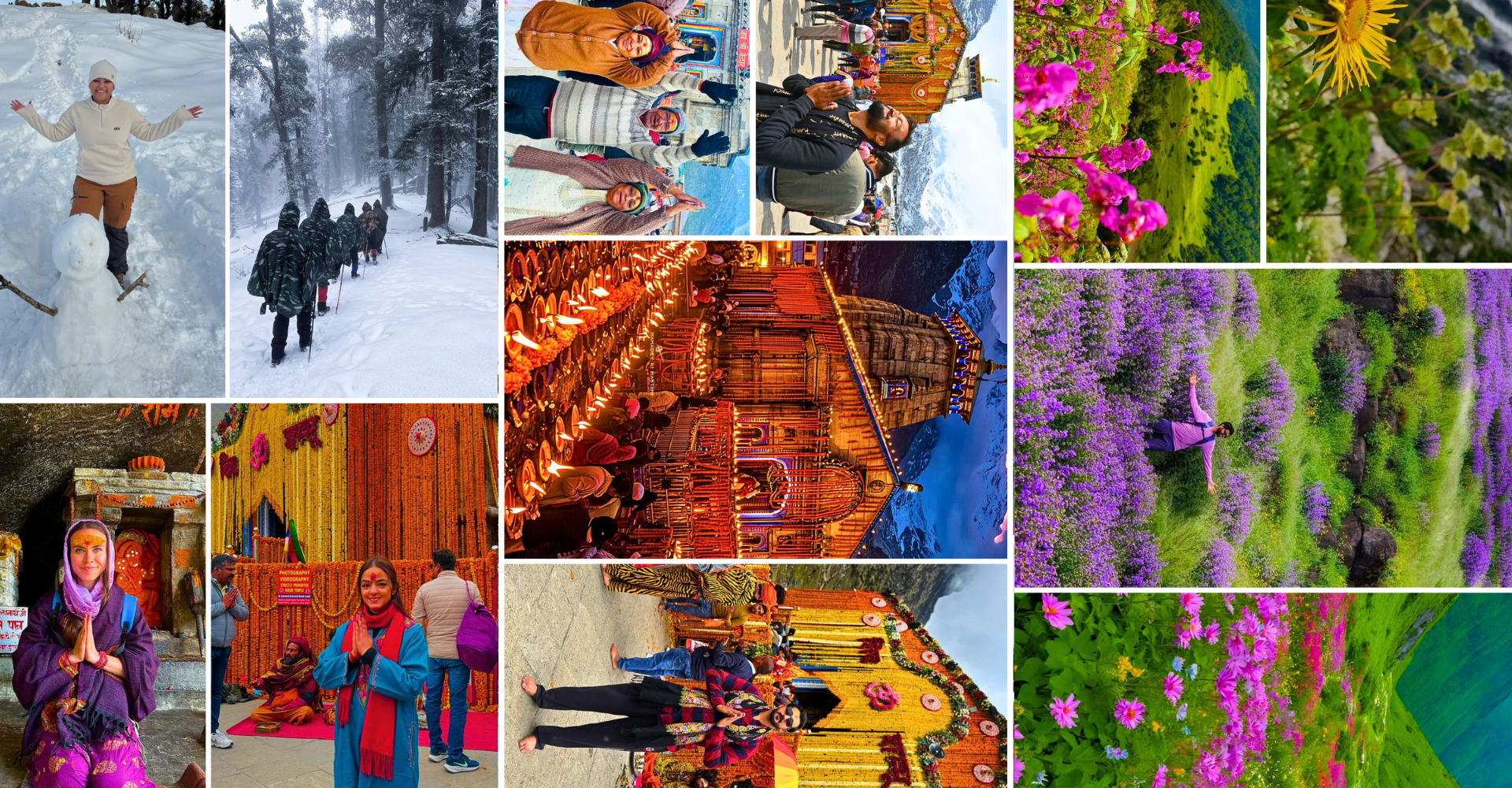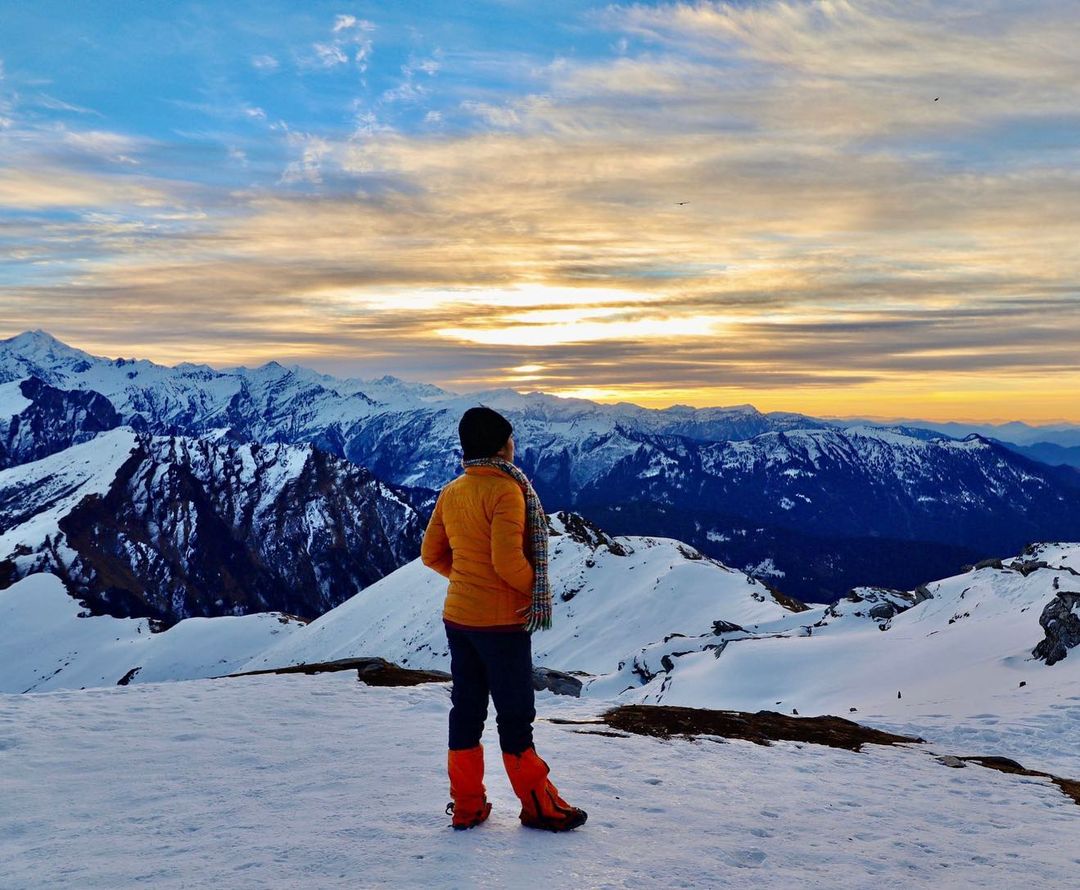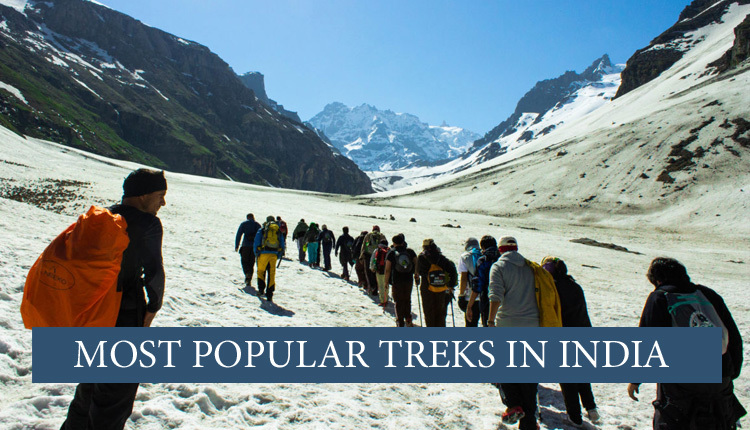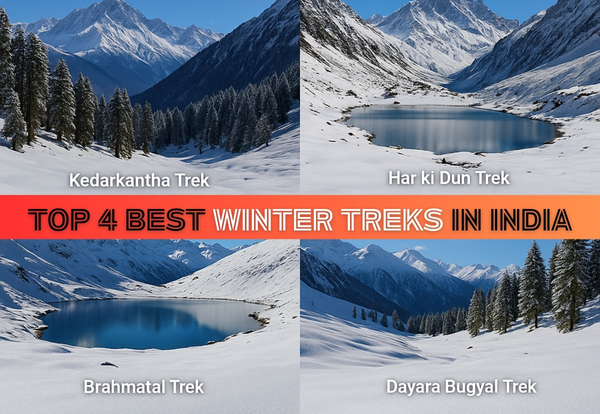Top 5 Most Popular Treks in Uttarakhand and Himachal Pradesh (India) to Explore in 2025
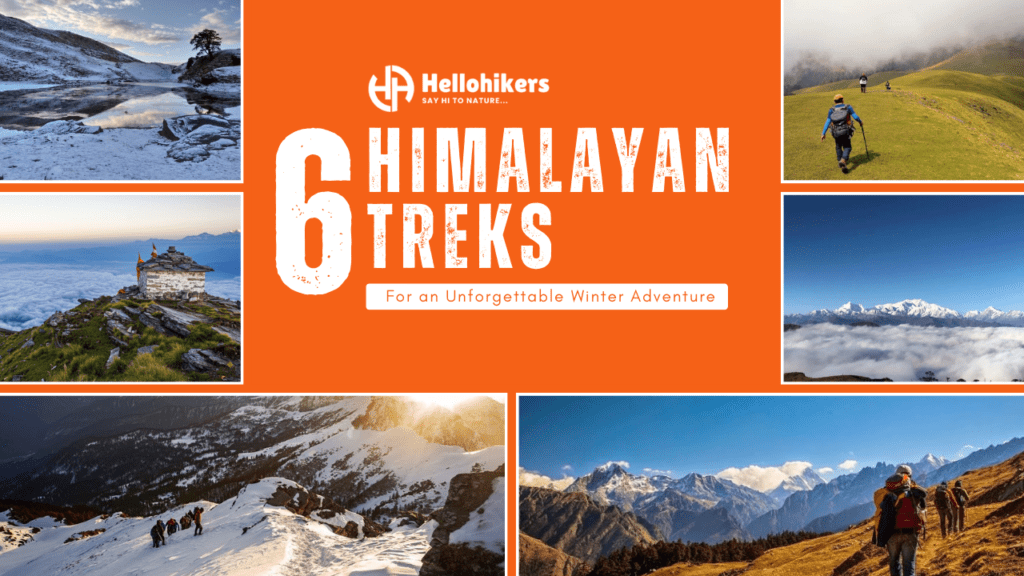
Sar Pass Trek: A Snowy Escape into the Heart of the Himachal Himalayas
Introduction
Looking for a snowy adventure deep in the Himalayas? The Sar Pass Trek is your answer. Nestled in the serene Parvati Valley of Himachal Pradesh, this trek offers an unbeatable mix of thrilling climbs, snowy trails, and panoramic views. Whether you're an amateur trekker or a seasoned mountain lover, this trek promises an experience of a lifetime.
Where is Sar Pass Trek Located?
The Sar Pass Trek in Himachal begins from the vibrant town of Kasol and winds through scenic forests, alpine meadows, and remote Himalayan villages. It's a perfect introduction to high-altitude trekking, situated at an elevation of 13,850 ft.
Quick Facts:
Region: Parvati Valley, Kullu
Base Camp: Kasol
Altitude: 13,850 ft
Trek Distance: 48 km approx.
Duration: 5-6 Days
Difficulty: Easy to Moderate
Best Time: May to June & September to October
Highlights of the Sar Pass Trek
Snowfields even during late spring and early summer
Campsites like Grahan, Min Thach, Nagaru with breathtaking backdrops
River crossings, pine forests, and meadow walks
Panoramic view from Sar Pass
Why Choose Sar Pass Trek in Himachal?
The route is dotted with unique experiences — from local Himalayan culture in villages like Grahan to steep snow-covered trails near the Sar pass. The gradual increase in altitude makes this trek ideal for acclimatization, especially for beginners.
Full Day-by-Day Itinerary (Ideal for Sar Pass Trek Package Blogs)
Day 1: Kasol to Grahan Village
Trek through pine forests and easy inclines. Stay overnight in camps at Grahan.
Day 2: Grahan to Min Thach
A steeper climb through mixed forests opens into a wide clearing at Min Thach. Overnight camping.
Day 3: Min Thach to Nagaru
The trail gets snowy and the altitude noticeable. Views of Parvati Valley begin to open up.
Day 4: Nagaru to Sar Pass to Biskeri Thach
The most rewarding day. Cross the Sar Pass and descend into lush meadows. Unforgettable views.
Day 5: Biskeri Thach to Barshaini and drive back to Kasol
A gentle descent with scenic waterfalls and dense forests.
What’s Included in a Sar Pass Trek Package?
Most operators include:
Stay (camping/accommodation)
Meals (veg)
Experienced trek leaders
First aid & safety gear
Permits & logistics
Budget Breakdown for Sar Pass Trek Package
Cost Item
Average Price (INR)
Trekking Package
6,000 - 9,000
Travel to Kasol (R/T)
2,000 - 4,000
Gear Rental (if needed)
500 - 1,500
Miscellaneous
1,000+
Estimated Total Budget: ₹10,000 - ₹15,000
Is Sar Pass Trek Suitable for Beginners?
Yes! The trek offers everything a beginner could ask for:
Moderate elevation gain
Guided routes
Clearly marked trails
Stunning scenery without extreme difficulty
Health & Safety Tips
Train with cardio workouts 2 weeks before
Stay hydrated and eat well during the trek
Carry essentials like sunglasses, sunscreen, and energy bars
Listen to your trek leader at all times
Use of Visual Content for SEO Boost
Infographics: Route map, trek checklist
Charts: Budget vs. cost across seasons
Videos: Gear guide, campsite walkthroughs
These assets make the blog more shareable and backlink-worthy.
How to Make Your Trek Content Stand Out for Backlinks
Add original photos or custom-designed maps
Provide checklists and downloadable PDFs
Offer packing guides and cold-weather tips
Include a glossary of trekking terms (linkable asset)
Social Proof & Testimonials
Use real trekker testimonials or ratings from platforms like Google Reviews or TripAdvisor to build credibility and increase trust.
Conclusion: Why Sar Pass Trek Deserves Your Next Adventure
The Sar Pass Trek is more than just a snow trail — it’s a spiritual and scenic experience. Whether you're chasing your first snow trail or ticking off your 10th Himalayan adventure, Sar Pass won't disappoint. Book your Sar Pass Trek Package early to get the best slots and guides!
Start your journey today — the mountains are calling.
Har Ki Dun Trek: A Hidden Himalayan Gem Every Trekker Must Explore
Introduction
Explore the untouched beauty of Har Ki Dun Trek, one of the most scenic valleys in the Garhwal Himalayas. Surrounded by snow-clad peaks and ancient alpine forests, it’s a dream destination for trekkers looking for adventure, peace, and a deep connection with nature.
The Mythical and Cultural Significance
Har Ki Dun is known as the "Valley of Gods" and holds strong ties to the Mahabharata. It is believed that the Pandavas took this route on their way to heaven. The spiritual energy of the valley is palpable, especially in villages like Osla that house 3000-year-old temples and follow age-old traditions.
Starting Point: Sankri Village
Sankri serves as the base village for the Har Ki Dun Trek in Uttarakhand. This remote hamlet is located 200 km from Dehradun and is well connected via road. From here, trekkers move toward Taluka, and then ascend through dense forests, quaint bridges, and meadows.
Route Overview and Itinerary
Day 1: Drive from Dehradun to Sankri (200 km)
Day 2: Trek from Sankri to Seema via Taluka (12 km)
Day 3: Seema to Har Ki Dun Valley (11 km)
Day 4: Explore Har Ki Dun Valley
Day 5: Return trek to Seema
Day 6: Trek back to Taluka and drive to Sankri
Day 7: Depart from Sankri to Dehradun
Landscape and Natural Attractions
The trek offers a rich mix of terrains—from lush green forests and meadows to snow-covered paths. You'll encounter waterfalls, alpine flowers, and the pristine Tons River. Har Ki Dun also gives panoramic views of Swargarohini I–IV, Black Peak, and Bandarpoonch.
Wildlife and Flora
Expect sightings of Himalayan Monals, Langurs, and possibly even the elusive black bear. The trail is also rich in flora, including rhododendrons, orchids, and deodar forests. This makes it not just a trekker’s paradise but a nature lover’s haven too.
Best Time to Visit
The ideal months to undertake the Har Ki Dun Trek are:
Spring (April to June): Blooming flora, clear trails, and pleasant weather
Autumn (September to November): Crisp skies, golden hues, and clearer mountain views
Avoid trekking during the monsoon (July–August) due to the risk of landslides and slippery paths.
What Makes Har Ki Dun Different from Other Treks
Seclusion: Less crowded compared to other Himalayan treks
Culture: Authentic Garhwali traditions and ancient temples
Diversity: Mix of forest, meadow, river, and glacier terrains
Packing Essentials for the Trek
Trekking shoes with good grip
Multiple thermal layers
Raincoat or poncho
UV-protected sunglasses
Water purification tablets
Personal medications and first aid kit
Difficulty Level and Physical Preparation
Har Ki Dun is considered a moderate trek. While beginners can attempt it, a certain level of fitness is necessary. Prepare by doing regular cardio and leg-strengthening exercises at least a month before the trek.
Booking the Best Har Ki Dun Trek Package
Choose a trekking company that offers the Best Har Ki Dun Trek Package:
Local guides with high-altitude experience
Meals and camping equipment
Safety gear like oxygen cylinders and first-aid
Eco-friendly practices (no single-use plastics, proper waste disposal)
Accommodation Options
Accommodation is typically in camps or village homestays. Both options offer a cozy and culturally immersive experience. Many trekkers find the homestays in Osla and Seema particularly charming.
Food and Local Delicacies
Expect nutritious, locally sourced meals. Dishes like aloo ke gutke, mandua roti, and pahadi dal are commonly served. Trek operators also provide basic North Indian meals suitable for high-energy needs.
Safety Tips and Guidelines
Always carry your ID and permits
Follow your trek leader’s instructions
Keep yourself hydrated
Avoid littering and follow eco-trekking guidelines
Photography Spots Not to Miss
Osla Village Temple
Swargarohini Peak Viewpoints
Tons River Crossings
Sunrise at Har Ki Dun Valley
Final Thoughts
The Har Ki Dun Trek is more than just a physical journey—it’s a spiritual, cultural, and ecological experience. Whether you're trekking for the views, the solitude, or the adventure, this hidden Himalayan valley will stay with you forever.
Start planning your adventure now and let the journey transform you.
Valley of Flowers Trek: A Monsoon Paradise Bursting with Color
Introduction: Welcome to the Valley of Flowers Trek
Nestled in the heart of the Himalayas, the Valley of Flowers Trek is one of the most iconic trekking routes in India. Known for its breathtaking beauty and vivid floral landscapes, this trek offers an unforgettable experience, especially during the monsoon season. The valley bursts into life with a myriad of colors as flowers bloom in all their glory, making it a true paradise for nature lovers, trekkers, and photographers alike.
The Valley of Flowers is part of the UNESCO World Heritage Site and is located in the Uttarakhand state of India. It is an area of high-altitude alpine flora, making it a unique destination for anyone looking to experience the beauty of the Himalayan mountain range up close.
Why Monsoon is the Best Time for Valley of Flowers Trek
While the Valley of Flowers Trek in Uttarakhand is an all-year-round destination, the monsoon season is arguably the best time to experience its true splendor. From June to September, the valley transforms into a vibrant sea of colorful flowers, with species that are rarely found elsewhere.
During the monsoon, the valley is at its most lush, with the flora in full bloom. The monsoon rains nurture the flowers, turning the meadows into a painter's palette of hues. Flowers like the Blue Poppy, Brahma Kamal, Primula, and Siberian Iris dominate the landscape, making the trek feel like a stroll through an ethereal paradise.
Moreover, the rainy season brings cool temperatures and fewer tourists, providing a peaceful environment to enjoy the trek without the usual crowds.
Floral Diversity: What Makes the Valley of Flowers Unique
The Valley of Flowers Trek is renowned for its astonishing diversity of plants, making it a haven for botany enthusiasts. Home to over 500 species of wildflowers, the valley is one of the most botanically rich regions in the world.
The valley's flora is not just limited to beautiful flowers. It is also home to rare medicinal plants, including those used in traditional Ayurvedic practices. Some of the notable plants found here include the Marsh Marigold, Rhododendron, and Cobra Lily. Additionally, you’ll find Siberian Iris, Dwarf Dogwood, and several species of orchids.
This floral diversity attracts photographers, nature lovers, and researchers from all over the world who come to document the rare and beautiful plant life. Whether you're an amateur photographer or a seasoned pro, the valley offers endless opportunities to capture stunning images.
Trekking Through the Valley of Flowers
The Valley of Flowers Trek offers an easy-to-moderate difficulty level, making it ideal for trekkers of all skill levels. The trek starts from Govindghat, a small town in Uttarakhand, and leads to the picturesque Valley of Flowers National Park.
The trail is well-defined and takes you through dense forests, gushing streams, and vibrant meadows. As you ascend, you’ll encounter breathtaking views of the snow-capped peaks of the Himalayas, creating the perfect backdrop for your trek.
The highlight of the trek is the valley itself, where you’ll walk among a sea of wildflowers. The colors and scents will overwhelm your senses, creating a sensory experience like no other. You will also get a chance to spot wildlife such as the Musk Deer, Himalayan Black Bear, and several bird species, adding to the charm of the journey.
Flora, Fauna, and Scenic Beauty: A Visual Treat
As you trek through the Valley of Flowers, you’ll be surrounded by spectacular views. The pristine rivers, cascading waterfalls, and towering Himalayan peaks serve as the perfect backdrop to the valley's floral abundance.
In addition to the stunning flowers, the valley is rich in wildlife. Spotting a Musk Deer or the elusive Himalayan Monal bird in the wild is a treat for nature lovers and photographers. The dense forests of oak and deodar trees provide a habitat for these animals, and the rushing rivers create a soothing symphony of sound as you trek along.
The picturesque surroundings, combined with the valley’s floral beauty, create a serene and unforgettable trekking experience. Whether you are a seasoned trekker or someone looking to enjoy nature at its finest, the Valley of Flowers Trek Package offers something for everyone.
Essential Tips for Trekking in the Monsoon
The monsoon season can present unique challenges, but with the right preparation, it can be the best time to experience the valley’s beauty. Here are some essential tips for trekking during the monsoon:
Footwear: Ensure you have waterproof trekking boots with good grip. The trails can get slippery, and proper footwear will help prevent accidents.
Clothing: Wear moisture-wicking and quick-drying clothes. The rain can be unpredictable, so a rain jacket is a must.
Safety: Be mindful of the trails, as the monsoon season can lead to landslides and wet paths. Always trek with a guide and follow local safety guidelines.
Hydration: Carry enough water, as the higher altitudes and moderate trekking can cause dehydration.
How to Book Your Valley of Flowers Trek Package
Booking your Valley of Flowers Trek Package is easy with the right trekking agency. A professional trekking operator will provide all the necessary equipment, experienced guides, and safety precautions needed for a successful trip.
You can opt for a 5-6 day trek starting from Govindghat, including transportation, accommodation, meals, and other necessary services. Packages typically include permits to enter the valley and accommodation at local guesthouses.
To get the best experience, choose a package that suits your preferences and fitness level. Many operators offer customized itineraries based on your trekking goals and duration.
Conclusion
The Valley of Flowers Trek during the monsoon season is an experience like no other. With its vibrant wildflower meadows, stunning Himalayan landscapes, and rare wildlife, it’s no wonder that this trek is considered one of the most scenic and enchanting treks in the world.
Whether you’re a beginner or a seasoned trekker, the Valley of Flowers Trek in Uttarakhand offers something for everyone. Plan your trek today and immerse yourself in the floral dream of the Himalayas!
Hampta Pass Trek: A Stunning Crossover from Lush Valleys to Barren Spiti
Introduction: A Trekker's Dream Come True
The Hampta Pass Trek is an incredible journey through the diverse landscapes of the Indian Himalayas. Known for its unique crossover from the lush valleys of Kullu to the barren desert-like terrain of Spiti, this trek offers an experience that combines both adventure and tranquility. Whether you're a seasoned trekker or a beginner, the Hampta Pass Trek in Himachal is a must-do for anyone seeking a thrilling Himalayan adventure.
What Makes the Hampta Pass Trek So Special?
The Hampta Pass stands out for its dramatic change in landscapes. As you trek through forests, alpine meadows, and snow-covered passes, the contrast of the lush greenery of Kullu with the dry, rugged terrain of Spiti is absolutely stunning. This seamless transition makes the Hampta Pass Trek one of the most breathtaking routes in the Himalayas.
Lush Valleys and Forests of Kullu: The trek begins in the serene Kullu valley, where you are surrounded by tall trees, flowing rivers, and vibrant meadows.
Barren Spiti: Upon crossing the pass, the trek opens up to Spiti, with its stark, desert-like scenery and rugged mountain views, offering trekkers an entirely new perspective of the mountains.
The Hampta Pass Trek Route
The Hampta Pass Trek spans around 35-40 kilometers and takes 5 to 6 days to complete. Here's a breakdown of the route:
Day 1: Manali to Jobra - Your journey begins with a scenic drive to Jobra, which marks the starting point of the trek.
Day 2: Jobra to Chika - The first trekking day takes you through dense pine forests, past streams, and into meadows with panoramic views of the snow-covered peaks.
Day 3: Chika to Balu ka Ghera - This section takes you further into the Himalayas, where you camp near a beautiful river, surrounded by towering mountains.
Day 4: Balu ka Ghera to Hampta Pass and Chatru - The toughest and most exciting part, this day takes you over the Hampta Pass, offering incredible 360-degree views of the surrounding valleys.
Day 5: Chatru to Manali - The final leg of the trek leads you to Chatru, where you’ll be driven back to Manali.
The Best Time to Go on the Hampta Pass Trek
The best time to trek Hampta Pass is from mid-June to mid-September. During these months, the weather is pleasant, and the paths are clear of snow, making it an ideal time for trekking. The Hampta Pass Trek in Himachal offers a cool climate during summer, allowing trekkers to experience the lush green valleys and the snow-capped peaks at their best.
Why Choose a Hampta Pass Trek Package?
Choosing a Hampta Pass Trek Package ensures that you have everything you need for a smooth trekking experience, including expert guides, camping equipment, meals, and permits. This option takes the hassle out of planning, letting you focus entirely on enjoying the adventure. Additionally, experienced trek leaders ensure your safety and enhance your overall experience.
Conclusion: A Trek You Will Never Forget
The Hampta Pass Trek is an exceptional journey that offers both natural beauty and adventure. Whether you are drawn to its changing landscapes, its challenge, or its peaceful campsites, this trek promises to leave you with lasting memories. With a well-planned Hampta Pass Trek Package, you can make the most of this once-in-a-lifetime Himalayan adventure.
Kedarkantha Trek: The Ultimate Winter Wonderland Adventure in Uttarakhand
Introduction to the Kedarkantha Trek
The Kedarkantha Trek in Uttarakhand is one of India’s most beloved winter treks, offering an immersive experience in the majestic Himalayas. Whether you're a seasoned trekker or just beginning your trekking journey, this trek promises awe-inspiring views, fresh alpine air, and the thrill of conquering a snow-covered summit. Known for its picturesque beauty, Kedarkantha is the perfect destination for anyone looking to explore the Himalayan landscape in winter.
Why Choose Kedarkantha Trek in Uttarakhand?
1. The Scenic Beauty of Kedarkantha Trek
The Kedarkantha Trek offers some of the most stunning views in Uttarakhand. From the summit, trekkers are greeted with panoramic vistas of snow-clad peaks, dense pine forests, and alpine meadows. Kedarkantha provides an unmatched winter wonderland experience, particularly during the winter months when snow blankets the entire region.
2. Perfect for All Levels of Trekkers
Whether you're a beginner or an experienced trekker, the Kedarkantha Trek is designed to be accessible to all levels. The gradual incline, well-marked trails, and manageable difficulty make it ideal for newcomers to trekking, while still challenging enough to excite seasoned adventurers.
3. Adventure and Camping Experience
The trek is also known for its pristine camping spots. Set up camp in places like Juda Ka Talab and Kedarkantha Base Camp, where the serenity and beauty of nature envelop you. The night skies, filled with stars, and the fresh, crisp air make camping a unique experience on the Kedarkantha Trek.
The Kedarkantha Trek Route and Itinerary
1. Starting Point: Sankri Village
The trek begins at Sankri, a picturesque village in Uttarakhand, which is the base camp for the Kedarkantha Trek in Uttarakhand. From Sankri, you begin the trek by passing through dense forests and small mountain villages, where you’ll get a taste of local life and culture.
2. Juda Ka Talab: First Campsite
The first campsite on the trek is Juda Ka Talab, a serene and beautiful spot that offers breathtaking views of the snow-covered trails and forests. The frozen lake at Juda Ka Talab adds to the charm of this campsite, making it a perfect spot for trekkers to rest.
3. Kedarkantha Base Camp: A Gateway to the Summit
The Kedarkantha Base Camp is where trekkers make their final preparations before summiting. It is the ideal place to rest, acclimatize, and enjoy the beauty of the Himalayan ranges. From here, trekkers will wake up early for the final ascent to the summit.
4. The Summit: Conquering Kedarkantha Peak
The final day of the Kedarkantha Trek involves an early morning ascent to the summit, where trekkers are rewarded with panoramic views of the snow-covered peaks and valleys below. The Kedarkantha peak stands at an elevation of 12,500 feet, making it one of the most accessible high-altitude treks in India.
Best Time to Trek Kedarkantha
The best time to undertake the Kedarkantha Trek in Uttarakhand is during the winter months, from December to February. The winter season covers the trek in snow, creating a magical winter wonderland. For those looking for clear skies, crisp air, and the thrill of trekking through snow-covered landscapes, winter is the best time.
What to Pack for the Kedarkantha Trek
Before embarking on your Kedarkantha Trek, it’s essential to pack the right gear. Here's a checklist of what you need:
Warm clothing (jackets, thermals, gloves, etc.)
Trekking boots
Waterproof pants and jackets
Headlamps and extra batteries
Sleeping bags for cold conditions
Trekking poles
Kedarkantha Trek Package: What’s Included
A typical Kedarkantha Trek Package includes:
Transportation from Dehradun to Sankri
Experienced trek guides
Accommodation in camps and guesthouses
All meals during the trek
Trekking permits
These packages are designed to make the trekking experience smooth and hassle-free, allowing trekkers to focus solely on enjoying the adventure.
Conclusion: Why Kedarkantha Should Be on Your Trekking List
In conclusion, the Kedarkantha Trek is the ultimate winter trekking destination for nature lovers, adventure seekers, and beginners alike. The stunning views, accessible trails, and picturesque campsites make it an unforgettable experience. Whether you're looking for a peaceful winter escape or an exciting adventure, the Kedarkantha Trek in Uttarakhand should be on every trekker’s bucket list.
Note: IndiBlogHub features both user-submitted and editorial content. We do not verify third-party contributions. Read our Disclaimer and Privacy Policyfor details.



